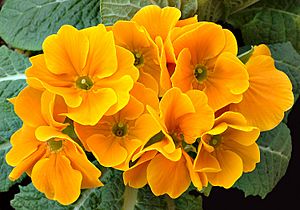Eudicots facts for kids
Quick facts for kids Eudicots (Tricolpates)Temporal range: Early Cretaceous - Recent
|
|
|---|---|
 |
|
| Scientific classification | |
| Kingdom: | |
| Division: | |
| (unranked): |
Eudicots
|
| Clades | |
|
|
Eudicots (pronounced "YOO-dee-kots") are a huge and important group of flowering plants. They are also known as Eudicotyledons (pronounced "YOO-dee-kot-uh-LEE-dons"). This group includes many plants you see every day. Think of forget-me-nots, cabbage, apple trees, dandelions, buttercups, maple trees, and even macadamia nuts.
Eudicots are one of the two main types of flowering plants. The other main type is called monocots. Scientists use special features to tell these two groups apart.
Contents
What Makes Eudicots Special?
Eudicots have several unique features that set them apart from other plants. These features help scientists classify them.
Pollen Grains
One of the most important features of eudicots is their pollen. Most eudicots have pollen grains with three grooves or openings. These grooves are called "colpi" (singular: "colpus"). This is why eudicots are sometimes called "tricolpates," meaning "three-grooved." This three-grooved pollen is a key way to identify them.
Seed Leaves
Eudicots get their name from their "cotyledons." A cotyledon is a seed leaf. It is the first leaf or leaves that appear when a plant sprouts from a seed. Eudicots usually have two cotyledons. This is different from monocots, which have only one.
Leaf Veins
If you look closely at the leaves of eudicots, you will notice a special pattern. Their leaves usually have veins that form a net-like or branching pattern. This is often called "reticulate venation." It looks like a network of tiny roads spreading out from a main vein.
Flower Parts
The flowers of eudicots often have parts in groups of four or five, or multiples of these numbers. For example, a eudicot flower might have four petals, eight stamens, or five sepals. This is a general rule, and there can be exceptions.
Stem Structure
Inside the stem of a eudicot, the plant's transport tissues are arranged in a ring. These tissues are called vascular bundles. They carry water and nutrients throughout the plant. This ring arrangement helps the plant grow wider and stronger.
Root System
Eudicots typically have a main taproot system. This means they have one large, central root that grows deep into the soil. Smaller side roots branch off from this main root. This strong root system helps anchor the plant and reach water deep underground.
Where Do Eudicots Grow?
Eudicots are found almost everywhere on Earth. They grow in forests, grasslands, deserts, and even in water. This group includes a huge variety of plants. You can find them in tropical rainforests and in cold, temperate regions. Their ability to adapt to many environments makes them very successful.
Examples of Eudicots
The eudicot group is incredibly diverse. It includes many plants that are important to humans and animals.
- Trees: Many common trees are eudicots, such as oak, maple, apple, and cherry trees.
- Shrubs: Roses, blueberries, and rhododendrons are all eudicots.
- Vegetables: Most of the vegetables we eat, like beans, peas, carrots, potatoes, and lettuce, are eudicots.
- Fruits: Apples, peaches, strawberries, and grapes are all eudicot fruits.
- Flowers: Sunflowers, daisies, roses, and buttercups are beautiful examples of eudicot flowers.
This wide range of plants shows how important eudicots are to our planet's ecosystems and to our daily lives.
How Eudicots are Classified
Scientists use a system called cladistics to group living things. A "clade" is a group of organisms that includes an ancestor and all of its descendants. Eudicots are considered a "clade" because they all share a common ancestor.
Within the eudicot group, there are many smaller groups, or "clades." These are listed in the taxobox at the top of this article. Some of the major groups include:
- Rosids: This large group includes many familiar plants like roses, apples, beans, and oaks.
- Asterids: Another very large group, including sunflowers, daisies, tomatoes, and mint.
Scientists are always learning more about how these plants are related. They use DNA studies to understand their family tree better.
Images for kids
See also
 In Spanish: Eudicotiledóneas para niños
In Spanish: Eudicotiledóneas para niños


